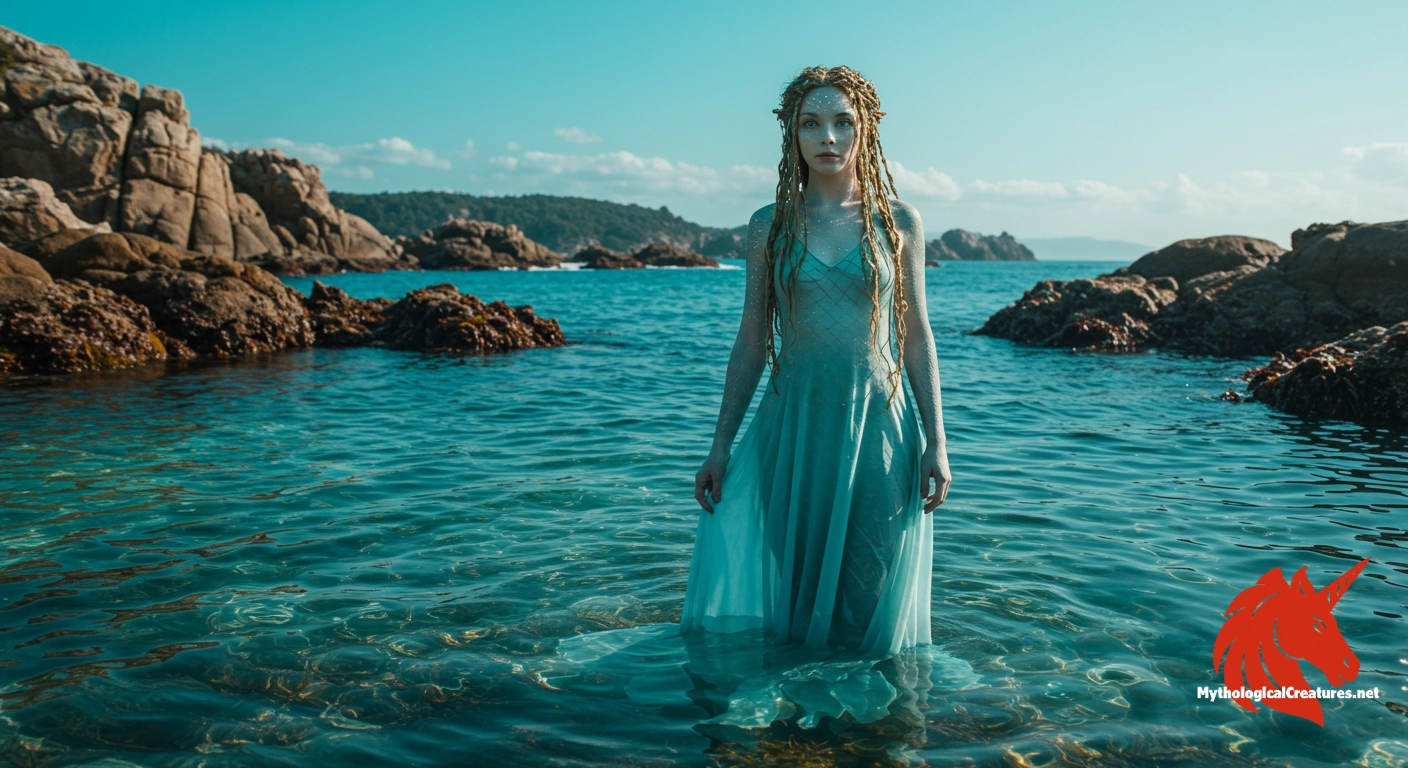Salacia: Salacia is the Roman goddess of salt water and the serene aspects of the sea.

Salacia
Salacia - Represents the essential nature of salt water and the tranquil, sunlit character of the ocean, playing a key role in the divine marine hierarchy as consort to Neptune.
Origins & First Encounters
Salacia emerges within the rich tapestry of Roman mythology as a revered goddess who personifies the calm and luminous aspects of the sea. Her origins are deeply rooted in the ancient Roman reverence for the natural forces of salt water, and her name, derived from the Latin word for salt, underscores that intrinsic connection. She is attested in varied literary sources from early Roman writings, where her serene beauty and dignified presence were contrasted with the tempestuous nature of other aquatic forces. Although she is often depicted in the company of Neptune, her image resonates with a distinct autonomy that celebrates both the mystery and bounty of the ocean. Salacia’s narrative captures a delicate interplay between divine desire and preserved virginity, marking her as an embodiment of celestial sensitivity. Her myth not only reflects the spiritual values of her era but also contributes to a broader cultural understanding of nature’s dual facets—both gentle and formidable. The cultural context of ancient Rome, with its blend of ritualistic practice and poetic expression, endowed her story with layers of meaning that continue to intrigue scholars today. In many respects, Salacia epitomises the harmonious balance between power and serenity, inviting reverence for the calm, sunlit expanses of the sea. Her enduring presence in Roman mythology serves as a testament to the timeless allure of water deities and their integral role in connecting humanity with the natural world.
Source Texts & Tale Variants
The myth of Salacia is woven through a diverse array of ancient texts and literary traditions that highlight the multifaceted nature of her persona. Classical authors such as Varro, Seneca, Augustine, and Servius provide varied attestations, each contributing nuanced details that enhance her mythological aura. Ancient priests even invoked her name during rituals, linking her to the broader tapestry of divine attributes in the Roman religious landscape. Multiple story variants circulate in the literary record, some emphasising her graceful evasion of Neptune’s fervour as a testament to her autonomous spirit. Other narratives illustrate her acceptance of marriage with Neptune, underscoring a dynamic interplay between desire and divine duty. Certain texts also hint at her association with mineralised springs, broadening her influence beyond the traditional confines of the ocean. This diversity of sources reveals a complex character whose legend was moulded by both official cult practices and informal oral traditions. The layered accounts of her mythology illustrate not only the flexibility of her character in various narratives but also the rich, evolving nature of ancient Roman religious thought.
Form & Powers
Salacia’s physical representation in art and literature is as captivating as the serene landscapes of the ocean she governs. She is depicted as a radiant nymph with flowing tresses intermingled with strands of seaweed, suggesting an organic fusion between her divine form and the marine environment. Her visage is often complemented by a crown fashioned from marine vegetation, which symbolically links her to the bounty of the ocean. Adorned in sumptuous, queenly robes that evoke the shimmering surface of sunlit waters, her appearance exudes both elegance and authority. Artists frequently capture her in scenes where she is either seated beside Neptune or partaking in a celestial chariot ride, often drawn by dolphins or sea-horses. The embellishment of nets in her hair hints at her dominion over the maritime realm while reflecting the intricate patterns of the underwater world. In some depictions, the play of light on her skin parallels the gentle glow of the sea at dawn, reinforcing her association with the calm side of Neptune’s kingdom. Although artistic renditions vary, each portrayal consistently emphasises her ethereal beauty and the harmonious blend of grace, power, and natural mystique that define her status.
Regional Faces
The myth of Salacia transcends the boundaries of traditional Roman lore, adapting seamlessly to diverse regional interpretations across the Mediterranean. In the Greco-Roman continuum, she is closely identified with the Greek Amphitrite, creating overlapping iconographies between two cultures that cherished marine deities. Some regional traditions further blend her identity with that of Tethys, thereby expanding her dominion to include broader aspects of water—from vast oceans to bubbling mineral springs. In coastal communities of Italy, local reverence often painted her as the embodiment of serene, sunlit seas, distinct from the more tempestuous deities of the deep. Variations in her myth allowed her narrative to be melded with local water cults, where she was sometimes celebrated for her nurturing qualities associated with spring waters. Her iconography in regional art and temple reliefs might display subtle differences in attire and accoutrements, reflecting indigenous aesthetic preferences and symbolic emphasises. Such adaptations not only reinforced the practical and spiritual importance of water in these communities but also helped integrate her myth into local festivals and maritime rites. The fluidity of her depiction across various regions highlights the adaptable nature of myth, underscoring a shared cultural admiration for the enchanting and life-sustaining qualities of the sea.
Cultural Parallels
Comparative analysis reveals that Salacia occupies a distinctive and multifaceted niche among water deities across varied mythological traditions. As the Roman counterpart to the Greek Amphitrite, she embodies an archetypal ideal of marine beauty and the tranquillity of the open sea. Her narrative, marked by the interplay of divine pursuit and graceful evasion, finds resonance in other cultural mythologies where water deities personify both nurturing and formidable energies. Similar motifs emerge in the lore of Nordic sea spirits and Celtic water nymphs, each celebrating the intrinsic connection between humanity and the aqueous world. Just as many cultures revere the gentle yet persistent nature of water, Salacia is portrayed as a symbol of balance between amorous passion and serene detachment. Her attributes, from the subtle crown of seaweed to the elegant portrayal in artistic chariots, mirror qualities found in other mythic figures who govern natural realms. The enduring appeal of such deities underscores a widespread human fascination with the mysteries and essential life forces of water. Through these comparative lenses, Salacia not only connects with analogous ancient figures but also enriches our broader understanding of how different cultures venerate the calming and transformative power of the sea.
Legacy & Modern Evolution
Throughout the centuries, the depiction of Salacia has evolved from a classical sea goddess to a symbol of maritime serenity and mystique. In Renaissance art and literature, her image was reimagined with an emphasis on both her ethereal beauty and the inexorable power of nature, reflecting the evolving relationship between humanity and the ocean. The cultural legacy of Salacia is evident in the enduring motifs that celebrate the gentle, life-affirming aspect of the sea, which continue to inspire modern artistic and literary works. Her association with Neptune and the graceful iconography of marine life have cemented her role in the pantheon of water deities, influencing successive generations' visual and poetic representations of the sea. Modern astronomers have kept her memory alive with the naming of celestial bodies, such as planetoid 120347 Salacia, thereby bridging ancient myth with contemporary science. In some coastal communities, Salacia’s myth persists in local traditions and maritime festivals, where her calm and nurturing influence over the sea is celebrated with symbolic rituals. Renewal of interest in classical mythology has led to revived interpretations that see her as a steward of environmental balance and ecological wisdom. This historical evolution not only underscores the timeless allure of her myth but also invites modern audiences to explore the cultural depths of a tradition that continues to shape our collective understanding of nature’s sublime beauty.
Interesting Fact
An interesting fact about Salacia is that the minor planet 120347 Salacia is named after her, linking her ancient myth to contemporary astronomical discoveries.
Quick Creature Info
Origin:
Associations:
Our Mythic Legendary Rating:

Also Sometimes Known As:
Habitat:
Supernatural Powers:
Physical Attributes:
Abilities:
Behavior:
Lore:
Related Creatures, Tales or Lore
References
Discover Another Mythical Legend You May Not Have Heard Of?
Uncover the mysteries of ancient folklore and expand your knowledge of legendary beings from cultures around the world.
Dare to Meet the Achiyalabopa....
Curated by the Mythological Creatures Team (rev. May 2025)
